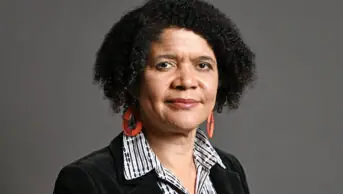
Paul Stuart
Realising the ambitions of the NHS ten-year health plan for England will require investment in the pharmacy workforce, the firm embedding of pharmacist prescribers in NHS services, clarity on what neighbourhood health services will offer and clearer information on how the different teams will work together.
This was the main message of a roundtable meeting hosted by The Pharmaceutical Journal on behalf of the Royal Pharmaceutical Society (RPS) on 30 September 2025 at its London headquarters.
Following the publication of the government’s NHS ten-year health plan in July 2025, the roundtable event brought together a panel of stakeholders from across pharmacy to explore how the government’s ambition could be realised and implemented from a pharmacy perspective (see Box).
The plan is built around three themes: shifting care into the community via a neighbourhood health service, switching focus from sickness to prevention and digitalising the NHS.
The plan promises the pharmacy sector a “vital role” in neighbourhood health services. GP-led local networks linking with pharmacists, other health and social care professionals, local government organisations and the voluntary sector will be initially rolled out across more deprived areas. It is also expected that pharmacies will take on expanded clinical roles, supporting long-term conditions, prevention, prescribing and vaccination. Pharmacies, the plan says, will move from “being focused largely on dispensing medicines to becoming integral to the neighbourhood health service, offering more clinical services”.
The plan also said that routine genomic testing will begin from 2026, while a single national formulary (SNF) will replace local lists within two years.
On the digital side, it is planned that the NHS App will use an artificial intelligence-enabled tool to help guide patients to appropriate local services. In addition, a feature called ‘My Medicines’ will help patients manage repeat prescriptions for delivery or collection, while reminding patients what medicines they need to take and when. The app will also start to include pharmacogenomics and drug interactions data.
It also says that pharmacogenomics will be integrated into NHS over-40s health checks from 2026.
When the plan was published, pharmacy bodies welcomed the ambitions but spoke of the challenge of turning those ambitions into reality. At the time, Janet Morrison, chief executive of Community Pharmacy England (CPE), said that CPE was “keen to start discussing the practicalities as soon as practicable”, while Leyla Hannbeck, chief executive of the Independent Pharmacies Association, said that “proper funding must be in place beforehand so we can plan, train and invest”.
The roundtable event was hosted by Michael Dowdall, executive editor, and Graham Clews, news and views editor, at The Pharmaceutical Journal.

Paul Stuart
Reflections from across sectors
Following introductory remarks, the first session began with attendees sharing their reflections on the plan, now that there had been time to digest and consider this further since its publication in July 2025. Reflections were generally positive, with attendees welcoming the profile pharmacy had been given in the plan’s focus on prevention of illness and greater localisation of care services; however, concerns about making the plan sustainable long term and how neighbourhood services would ensure fair distribution of resources were raised.
Tase Oputu, chair of the RPS’s English Pharmacy Board and associate director for medicines optimisation, medicines value and performance at Kent & Medway NHS Integrated Care Board (ICB), said it was “reassuring” to see that pharmacy was recognised throughout the ten-year plan and the recognition that pharmacy is at the heart of the local community and delivering outstanding patient care, which was something that was echoed by others in attendance.
Anne Joshua, deputy director of pharmacy commissioning and transformation at NHS England, said that the ten-year plan was a “step forward, especially for community pharmacy”, noting that “medicines were a golden thread through every chapter”. Laura Angus, chief pharmacy office and director of pharmacy and medicines optimisation at NHS Humber and North Yorkshire ICB, added that the plan was a “fantastic move to making better use of community pharmacy” but said “it’s the how” that was the question.
The roundtable attendees discussed the plan across several themes.

Paul Stuart
Workforce
Following publication of the plan, health secretary Wes Streeting announced that a new workforce plan to align with the ten-year plan was expected in the autumn of 2025. However, a call for evidence to inform the workforce plan was announced on 26 September 2025.
Nick Haddington, pharmacy dean for south west England at NHS England’s Workforce Training and Education Directorate, said that from a workforce perspective, the themes in the ten-year plan align well to what the directorate has been working on in the previous five years, which involves the reform of the initial education and training funds. He also said that some of the things in the plan “really resonate with what we’ve been talking about for a long time, which is pharmacists as medicines experts”. Stepwise management of chronic conditions “has been done effectively in general practice for a number of years is something that can, should and, I think, must be delivered in a community pharmacy setting”, he added.
Puja Nathwani, primary care workforce delivery manager at Brent Council, said she was pleased that the plan puts pharmacists at the forefront and “showcases what we can do”. Nathwani added that pharmacists have “been on the back foot in comparison to some other health professionals where we haven’t been forthcoming in terms of leadership — Where I work that’s something that I have been pushing, making yourself more open to different opportunities and leading from the forefront”. She also felt that one of the challenges on the new plan was around recruitment and retention of pharmacists and getting them upskilled.

Paul Stuart
Funding
The plan promises to “reinvent the NHS’ financial model” and “distribute NHS funding more equally locally, so it is better aligned with health need”, as well as a shift to longer-term financial planning.
Malcolm Harrison, chief executive at the Company Chemists’ Association (CCA), raised the question of: ‘What is the pharmacy need going to be in ten years’ time?’ He said that at the moment, the CCA is seeing around 1.2 million prescribed items annually in community pharmacies, and a conservative estimate for the future could be around another 400 million items per year. “The number of pharmacies over the last ten years has dropped by about 28%,” he said, adding that, therefore, the actual workload per pharmacy could grow by 64%. “What will help community pharmacy be able to survive, when currently it is recognised by NHS’s own economic view that it’s financially unviable now?” he asked.
Neighbourhoods
Minna Eii, advanced pharmacist practitioner at South Tyneside and Sunderland NHS Foundation Trust, said she felt that people do not always address the “business competition” element of neighbourhood health teams, adding that there is a “lot of fragmentation at the moment”, and she “would like to see an online service where I can have a choice of booking into a GP business, or a pharmacy business or a home visit service”. That way, “everyone gets a fair share, and everyone gets vaccinated”, she explained.
Digital
Nishali Patel, clinical lead for digital medicines at NHS England, said before the plan reaches the ten-year mark, the NHS app needs to create a “solid foundation” for offering access to services — particularly in the pharmacy space. She also said that for the first time, the NHS App is being spoken about through a medicines safety lens, as well as in terms of convenience, information and access. “That’s something that we need to explore and understand if there is a place for that within the app,” she said.
Eii asked what was being done to improve digital literacy of existing staff and the need for protected learning time to upskill in this area.

Paul Stuart
Opportunities and barriers to implementation
In the second session of the day, attendees shared what they saw as the plan’s main opportunities, as well as any barriers they felt needed to be addressed to fully implement it. An important theme of the discussions was on what neighbourhoods are for and how they will operate.
Haddington said that in neighbourhood teams “you need a system made up of component parts that understand each other and understand what patient change should look like”. He added that an enabler to the plan could be around training pharmacists and pharmacy technicians to “understand the system” — part of that is making sure that people have the opportunity to rotate between the organisations so they can see the patient journey. “They can understand that sectoral interface between the components and they can make sure that person can be signposted appropriately,” he said.
Nathwani said that in her area, there is a “big push to move from primary care networks to the neighbourhood model, and it is challenging”. The biggest barrier is “trying to get everyone on the same page”; however, it is a big opportunity for pharmacists and pharmacy technicians to get involved, she added.
Harrison said that while “everyone talks about neighbourhoods, I’m not actually seeing what a neighbourhood is”. He explained that there are currently 42 pilots. “How many neighbourhoods do we envision there being; how many variations on a theme are there going to be?” he asked.
Nick Kaye, chief executive of Community Pharmacy Cornwall and the immediate past chair of the National Pharmacy Association, said that Cornwall is already talking about integrated neighbourhood teams. “We still have a walk-in consultation service in Cornwall, with 60,000 consultations done in three years as a forerunner to Pharmacy First, and 25,000 consultations this year. You can walk in and get a consultation for anything. That’s an integrated neighbourhood team, right? That’s looking at all the assets you’ve got within a community to deliver that,” he said.
However, he added that within an integrated neighbourhood team, “we should capture those people that are actually in digital poverty — we don’t talk enough about that”.
Patel said that in future, she sees a possibility that the NHS App could help direct patients to local services — for example, by filtering on post code. “The data quality that supports that kind of future picture is going to be really essential to that. I don’t see that the app necessarily needs to be any more local than being able to support and sign post patients,” she said.
She also explained that the real place for the app is to do other things to facilitate patient convenience, noting that the recently rolled-out prescription tracking feature is very helpful. From a neighbourhood perspective, she said, more uptake of the app is being sought. Some ICBs already have targets in place for more patients to use the app, she added.
From a technicians’ perspective, Amy Laflin, president of the Association of Pharmacy Technicians UK (APTUK), said that scope of practise changes and supervision legislation will likely mean pharmacy technicians are more visible in the pharmacy, and it is important to offer support so that “everybody feels part of that transition”.

Paul Stuart
While the plan put a big emphasis on local community-based prevention and care, Oputu said that there is a need to make sure that secondary care and tertiary care “is funded, is recognised, is valued for all of the skills and the benefits that they bring to the patient — we shouldn’t look in isolation at the sectors”.
Oputu also asked: “How do we enable and bring our secondary care specialist pharmacists into the community?” She said: “There are examples of that happening, and a lot of good prevention work; things going on at Barts [Health NHS Trust] at the moment with cardiovascular care.”
“Let’s not just think in terms of neighbourhood teams. Let’s think about the hospital team. How do they connect; how do they communicate; how do they understand what’s going on in the community sector?” she asked.
Joshua said the shape of future contracts, such as the community pharmacy contractual framework, may have to be looked at because “one size fits all is hard to articulate at a local level”. NHS England was looking for a bottom-up approach from the independent prescribing pathfinder pilots to establish what it is that pharmacy offers and what is “common to all and presents best value for the public purse”, she added.
The ten-year plan said that a SNF for medicines would be developed within the next two years, with a new formulary oversight board supported by the National Institute for Health and Care Excellence (NICE). Current local formularies create “a postcode lottery”, the plan said.
Angus noted that there are “42-plus formularies out there at the moment”, and that a single formulary would “hopefully reduce duplication” in commissioning. “I don’t think the SNF will be the entire thing: it will be a framework, in my mind,” Angus said. She added: “We don’t all have to be in our silos: so, who is the most appropriate person to prescribe that drug for that patient? That’s what I would hope the SNF will target. I don’t think it will have every drug, and it cannot have every drug. It’s got to balance with the life science sector; it’s got to balance with pharma.”
Practicalities to facilitate implementation and delivery
Having discussed the opportunities and barriers, attendees turned to how to address the practicalities of plan delivery.
In terms of funding, Joshua admitted that the funding issue was a challenge but added that “we do want to crack on” around prescribing in NHS services.
“We need to absolutely address the issue of capacity to ensure access to medicines supply, in terms of where is that delivered, what does that look like, and optimising the services we have commissioned nationally,” she said.
She also raised that, with digital, the issue of harnessing the technology and innovation that already exists, noting that there is “massive innovation” in the private sector, while one challenge in the public sector is the 12-month cycle of funding.
Joshua highlighted the Barts Health NHS Trust cardiovascular disease initiative, in which 60 pathfinder sites were being trained by Barts Health NHS Trust to deliver the model. She described the initiative as “transformational”, with specialist and consultant hospital pharmacists going out to train pharmacy teams. “How can we do more of that?” she asked.
Oputu agreed that this was one way that the hospital workforce could be involved in the shift of care into the community, although she warned that this could be lost owing to a “risk of devaluing and underfunding”.
The government’s call for evidence to inform an NHS workforce plan closes on 7 November 2025. The future shape and size of the NHS workforce will clearly be essential to the implementation of the ten-year plan.
Commenting on the future workforce plan, Haddington said that “at a very basic level there needs to be some numbers in there”, especially around population change over the lifespan of the plan. “How many people are we going to have; what is the demographic of the population going to be? What are the health needs going to be, and how are those health needs going to grow, develop and change over time?” he asked.
Haddington said that “effective modelling” will sit alongside thinking about where the workforce at the moment. “How would we expect our workforce to grow over the coming period of time, given what we know about the MPharm pipeline, the number of pharmacy technicians we are training? Are we training the right number, too many, too few?” he added.

Paul Stuart
Independent prescribing
The plan said that as community pharmacists become increasingly able to independently prescribe, “we will increase their role in the management of long-term conditions, complex medication regimes and treatment of obesity, high blood pressure and high cholesterol”. “Over time”, community pharmacy would be linked up to the single patient record, the plan adds.
Angus said that if independent prescribers are not given NHS-commissioned services, they will deliver private services. “There are some fantastic private services,” she said, but added that “what bothers me about the private side of things is the inequality gap it creates, because some people cannot afford to go privately”. If pharmacists are qualified as prescribers, they have to have services to deliver in an NHS space, she explained.
Nathwani said that at a conference held recently, when asked, 80% of pharmacy staff said they could see themselves leaving their role in six months. “That was quite shocking. The reason for that was that there is no career pathway for them,” she explained. Nathwani said that “retention is a concern”, adding that when general practice became available for pharmacists and pharmacy technicians to move into, they shifted from community pharmacy into primary care. “And now what’s happening is that shift is going in a different angle, into the private sector” doing, among other things, online prescribing, she said. “That’s causing gaps in primary care and community pharmacy.”
Pharmacy technicians
Laflin asked how pharmacy technicians will be retained in roles that offer scope of practice increase. “With more responsibility, the likelihood is that pharmacy technicians are going to say, I want to move up a band; I want a pay rise,” she said. Laflin added that it is about how pharmacy technicians are offered the right level of support, balanced with opportunities to continue their scope of practice increase.
Harrison said that “this is not the NHS ten-year plan; it’s the government’s plan for the NHS. There’s a slight difference”, adding that many things in the plan are already being delivered and supported. Of the things in the plan that aren’t already entrained — including scaling up of Pharmacy First and modernising the approach to dispensing, pharmacy technicians taking on more — “that requires funding”, he said. Harrison also asked “if there isn’t any more taxpayer money available, what is going to be deprioritised, defunded, to enable the plan to deliver what it says?”

Paul Stuart
Priorities and calls to action
Finally, each attendee was asked for final thoughts and calls to action.
Patel suggested the levelling up of infrastructure and ensuring that every trust has the skills to manage and maintain electronic prescribing and medicines administration (EPMA) systems.
Oputu said, from an RPS perspective, that priorities were supporting the workforce through this change and advocating for people knowing the value of pharmacy.
Eii flagged the need for access to a single patient record.
Nathwani highlighted pharmacy leadership, which she described as pinpointing through the Royal College of Pharmacy a single voice of pharmacy and bringing that to the forefront.
Joshua said we need to hear more on what the public and patients think. Patient trust in pharmacy is “really high”, but patients need to be aware of further aspects of transformation, such as prescribing, she noted. Joshua added that an increase in pharmacists and pharmacy technicians taking part in the NHS clinical entrepreneur programme would also help.
Kaye emphasised the need for “stabilisation of our [community] network”, and from there, being open and honest about what transformation looks like.
Laflin said that from an APTUK side, workforce is the priority: recruitment and retention but also initial education and training, upskilling and supporting all pharmacy technicians across all sectors.
Harrison said a priority was to “make sure any plan is actionable and doesn’t just deliver today”, highlighting that demand was expected to soar in the next decade, so the plan must be future proofed to meet needs over the next ten years.
Haddington highlighted a need to ensure newly qualified pharmacists use and consolidate their new skills around prescribing. He also said that, broadly, there is a “need to develop and grow the supervisory capacity of the workforce” — both in clinical and educational capacities.
Angus said an immediate priority was the team that she works with, noting that there are 40 people who still don’t know if they have a job or not. Angus also said she had a “very strong interest” in the SNF, adding that “I want to be part of that; I want to influence it, I want to shape it as much as I can in the hope that we get it right and it does what it needs to do”.
Funding and workforce are often cited as important players in any form of NHS development. Attendees agreed that there was no difference if the ten-year plan was to be successfully implemented from a pharmacy perspective.
However, they also agreed that some effective horizon scanning was needed to establish exactly what the pressures on the health service would be in a decade’s time; that there was a need for pharmacy organisations to work together to help shape the future and then be open with pharmacy staff about how that would look; and that pharmacists needed support and guidance as their roles evolve as the ten-year plan is rolled out.
Dowdall concluded the meeting by thanking everyone for attending and for their valued contributions.
Box: Attendees
- Laura Angus, chief pharmacy officer and director of pharmacy and medicines optimisation at NHS Humber and North Yorkshire Integrated Care Board (ICB);
- Minna Eii, advanced pharmacist practitioner at South Tyneside and Sunderland NHS Foundation Trust;
- Nick Haddington, pharmacy dean for south west England at NHS England’s Workforce Training and Education Directorate;
- Malcolm Harrison, chief executive of the Company Chemists’ Association;
- Anne Joshua, deputy director of pharmacy commissioning and transformation at NHS England;
- Nick Kaye, chief executive of Community Pharmacy Cornwall and immediate past chair of the National Pharmacy Association;
- Amy Laflin, president of the Association of Pharmacy Technicians UK;
- Puja Nathwani, primary care workforce delivery manager at Brent Council;
- Tase Oputu, associate Director for medicines optimisation, medicines value and performance at Kent & Medway NHS ICB and chair of the Royal Pharmaceutical Society’s English Pharmacy Board;
- Nishali Patel, clinical lead in digital medicines at NHS England.
Apologies were received by Rob Connah, president of the Guild of Healthcare Pharmacists, and Jatinder Harchowal, chief pharmacist at University College London Hospitals NHS Foundation Trust.


